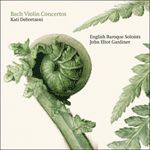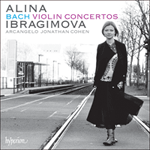By the 1720s Vivaldi’s concertos for violin and just about every other instrument under the sun had fuelled something of a concerto craze throughout Europe. Bach was not immune to the Italian’s influence; and both outer movements of the Violin Concerto in A minor, BWV1041, owe a debt to Vivaldi in their propulsive, catchy themes, and their use of Vivaldian ritornello structure, in which orchestral tuttis alternate with solo episodes. The arresting rhythmic motif that launches the first movement is just the kind of gambit Bach picked up from across the Alps. Yet even at his most Italianate, Bach cannot resist Teutonic elaboration and development. Compared with Vivaldi’s, his textures and harmony are more complex, and the division between solo and tutti episodes less clear-cut. Opening in fugal style (with the theme propounded in turn by first violins, second violins and basses), the finale is a bouncy 9/8 gigue that grows more and more virtuosic, culminating in a dazzling display of string-crossing. Between these exhilarating fast movements, the C major Andante is a rapt meditation, with the soloist spinning a quasi-improvised cantilena over a sternly repeated bass motif—a free, Bachian variant of the traditional Baroque ground bass.
from notes by Richard Wigmore © 2015
Dans les années 1720, les concertos de Vivaldi pour violon et pour la plupart des autres instruments existant sous le soleil avaient suscité un engouement pour les concertos dans toute l’Europe. Bach ne fut pas insensible à l’influence du compositeur Italien et les deux mouvements externes du Concerto pour violon en la mineur, BWV1041, doivent beaucoup à Vivaldi avec leurs thèmes entraînants et l’utilisation de la structure de ritournelle vivaldienne, où les tutti de l’orchestre alternent avec des épisodes du soliste. Le motif rythmé saisissant qui lance le premier mouvement n’est qu’un procédé d’au-delà des Alpes repris par Bach. Cependant, même lorsqu’il s’italianise au maximum, Bach ne peut résister à l’élaboration et au développement germaniques. Comparées à celles de Vivaldi, ses textures et son harmonie sont plus complexes, et la division entre les épisodes solo et tutti est moins nette. Commençant dans un style fugué (avec le thème exposé tour à tour par les premiers violons, les seconds violons et les basses), le finale est une gigue pleine d’allant qui devient de plus en plus virtuose, culminant dans une démonstration éblouissante de doubles cordes. Entre ces mouvements rapides grisants, l’Andante en ut majeur est une méditation profonde, le soliste tissant sa cantilène presque improvisée sur un motif de basse répété avec opiniâtreté—une variante libre de Bach de la basse obstinée traditionnelle de l’ère baroque.
extrait des notes rédigées par Richard Wigmore © 2015
Français: Marie-Stella Pâris
Bis zu den 1720er Jahren hatten Vivaldis Konzerte für Violine sowie für praktisch alle anderen existierenden Instrumente eine Art Solokonzert-Fieber in ganz Europa ausgelöst. Auch Bach war gegen den Einfluss des Italieners nicht immun—die beiden Außensätze des Violinkonzerts in a-Moll, BWV 1041, sind Vivaldi in ihren vorwärtstreibenden, eingängigen Themen sowie in der Ritornell-Struktur verpflichtet, wobei Orchestertutti mit Solo-Episoden alternieren. Das fesselnde rhythmische Motiv, mit dem der erste Satz eröffnet wird, ist genau die Art Figur, die Bach sich von der anderen Seite der Alpen angeeignet hatte. Doch selbst in italienischster Verfassung kann Bach der teutonischen Aus- und Durchführung nicht widerstehen. Im Vergleich zu den Werken Vivaldis sind seine Strukturen und Harmonien komplexer, und die Aufspaltung zwischen Solo- und Tutti-Episoden weniger eindeutig. Das Finale beginnt fugenartig (das Thema wird abwechselnd von den ersten Violinen, zweiten Violinen und Bassstimmen vorgetragen) und entwickelt sich dann in eine federnde, zunehmend virtuose 9/8-Gigue, die in äußerst behänden Saitenwechseln gipfelt. Zwischen diesen belebenden, schnellen Sätzen erscheint das Andante in C-Dur wie eine verzückte Meditation, in der der Solist seine quasi-improvisierte Kantilene über einem sich streng wiederholenden Bass-Motiv fortspinnt—eine freie Bach’sche Variante des traditionellen barocken Basso ostinato.
aus dem Begleittext von Richard Wigmore © 2015
Deutsch: Viola Scheffel


 Bach: Violin Concertos - Vinyl Edition
Bach: Violin Concertos - Vinyl Edition Hyperion sampler - September 2025 Vol. 2
Hyperion sampler - September 2025 Vol. 2 Bach: Violin Concertos
Bach: Violin Concertos Bach: Violin Concertos
Bach: Violin Concertos Bach: Violin Concertos & Sonatas
Bach: Violin Concertos & Sonatas
